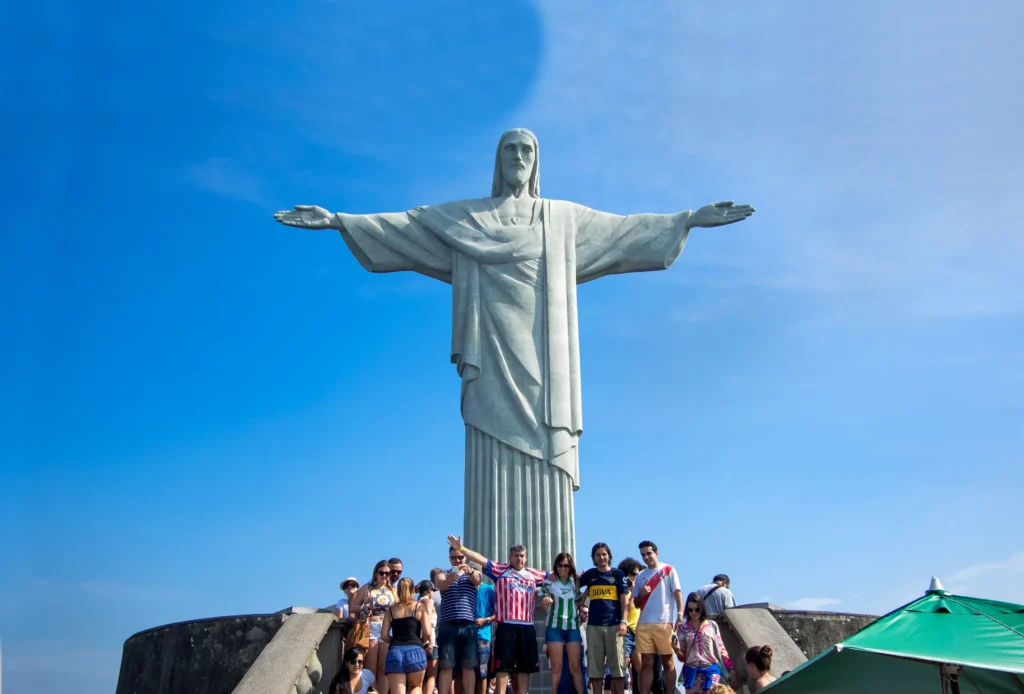
Towering gracefully atop Mount Corcovado, arms outstretched in eternal welcome, the Christ the Redeemer statue is far more than just a colossal figure—it is a soul-stirring emblem of peace, faith, and the spirit of Brazil. Overlooking the vibrant, pulsating city of Rio de Janeiro, this iconic statue has become one of the most recognizable and photographed monuments in the world, drawing millions of pilgrims, tourists, and admirers year after year.
To stand in the presence of Cristo Redentor, as it is known in Portuguese, is to witness the seamless fusion of natural beauty, human artistry, and divine reverence. Whether viewed from a plane flying into Rio, from the white sands of Copacabana, or from its very base on the mountaintop, Christ the Redeemer embodies hope, unity, and enduring belief—a guardian watching over the people and the breathtaking landscapes of Brazil.
A Vision Realized: The Origins Of A National Symbol
The idea of building a religious monument atop Corcovado Mountain began as early as the 1850s, when Father Pedro Maria Boss proposed a Christian landmark to honor Princess Isabel. The idea faded for a time but regained momentum in the 1920s when the Catholic Circle of Rio proposed a statue to commemorate Brazil’s centenary of independence from Portugal.
In 1922, with strong public support and funding from Brazilian citizens and the Catholic Church, the project was approved. French sculptor Paul Landowski was commissioned to design the statue, while Brazilian engineer Heitor da Silva Costa and French engineer Albert Caquot led its construction. The Art Deco masterpiece was completed in 1931, after nine years of planning and building.
Standing 30 meters (98 feet) tall, with an additional 8-meter (26-foot) pedestal and 28-meter (92-foot) arm span, Christ the Redeemer remains the largest Art Deco statue in the world. Constructed from reinforced concrete and soapstone, chosen for its durability and smooth finish, the statue has endured nearly a century of tropical weather and remains a pristine symbol of Rio and Brazil itself.
The Ascent: Journey To The Summit
Getting to Christ the Redeemer is an experience in itself. The statue sits atop Mount Corcovado, which rises 710 meters (2,329 feet) above sea level, offering an unparalleled panoramic view of Rio de Janeiro’s urban beauty and natural splendor.
There are several ways to reach the summit:
- Corcovado Train: Perhaps the most popular and scenic option. This electric cog train, operating since 1884, winds its way through the lush Tijuca National Forest, one of the world’s largest urban rainforests. The 20-minute journey offers glimpses of waterfalls, dense tropical flora, and monkeys swinging through the trees.
- Van Services: Official vans depart from popular locations like Copacabana, Largo do Machado, and Paineiras, transporting visitors up the mountain via well-maintained roads.
- Hiking Trails: For the adventurous, trails like the Parque Lage to Corcovado hike take you through steep rainforest terrain. While challenging, the reward is a deeply immersive experience of nature, culminating in one of the world’s most extraordinary views.
Upon arrival, a series of escalators and elevators, added in 2003, make the final ascent to the statue’s base more accessible, though some choose to climb the 220 steps that still remain, echoing a kind of spiritual pilgrimage.
Standing Beneath The Savior: A Profound Encounter
Reaching the summit and standing at the base of Christ the Redeemer is an awe-inspiring moment. The figure, carved in serene expression and open arms, seems to embrace the city and its people below.
At this height, Rio de Janeiro unfurls in all directions:
- To the south, the white crescents of Copacabana and Ipanema kiss the Atlantic.
- To the east, Sugarloaf Mountain stands sentinel at the bay’s entrance.
- To the north, Maracanã Stadium, once the largest football stadium in the world, pays homage to Brazil’s sporting soul.
- To the west, the peaks of Pedra da Gávea and the infinite stretch of forest form a natural fortress around the city.
The spiritual gravity of this place is palpable. Whether you are religious or secular, the sheer power of the moment—the scale, the silence above the city, the harmonious interplay between creation and creator—can move even the most stoic visitor.
Many stand quietly, arms mimicking the statue’s iconic pose, others pray, cry, or simply stare in reverent silence. The moment becomes not just about Christ or Christianity, but about transcendence, human connection, and wonder.
A Living Icon: Cultural And Religious Significance
Christ the Redeemer is more than a monument—it is a spiritual beacon and national pride. During religious holidays, the statue becomes a site of massive gatherings, open-air masses, and candlelit vigils.
In times of crisis, like during the COVID-19 pandemic, the statue was lit with messages of hope, flags of affected nations, and visual tributes to healthcare workers—reinforcing its role as a global symbol of compassion and solidarity.
The statue is also a UNESCO World Heritage Site, listed under “Rio de Janeiro: Carioca Landscapes Between the Mountain and the Sea,” recognizing how human creation and natural beauty merge to form something universally admired.
In pop culture, Christ the Redeemer has appeared in films, music videos, sports broadcasts, and even video games, making it one of the most recognizable landmarks on Earth.
Best Times To Visit: Weather, Light, And Atmosphere
- Early Morning (7–9 AM): The mountain is often shrouded in mist, and when it clears, you’re rewarded with the most magical, uncrowded views. Great for photography and calm reflection.
- Late Afternoon (4–6 PM): The golden light bathes the statue and city in warm hues. Sunset here is extraordinary but can be crowded.
- Cloudy Days: Sometimes the statue itself is hidden by clouds—yet this has its own mystique. The sudden reveal of the figure as mist parts can be an emotional moment.
Avoid midday on sunny days if possible—heat and crowds can affect the experience, and the light is often too harsh for good photos.
Conservation Efforts And Challenges
Though made of durable soapstone, Christ the Redeemer is vulnerable to the elements, particularly lightning, which strikes it several times each year. Repairs are regularly carried out to replace damaged stone and reinforce its structure. In fact, in 2014, lightning damaged the statue’s right thumb, sparking a major conservation effort.
To protect the site’s sanctity and environmental surroundings, Tijuca National Park authorities work in tandem with city officials and UNESCO to manage tourism, pollution, and forest preservation. Visitors are reminded to respect the site, both as a religious sanctuary and a delicate mountaintop ecosystem.
Why It Matters: A Personal And Collective Journey
To embrace the grandeur of Christ the Redeemer is to embrace something larger than life—a collective dream, a national identity, a spiritual anchor, and a marvel of human craftsmanship.
For Brazilians, it is the heart of the nation. For travelers, it is a pilgrimage to one of the New Seven Wonders of the World. For all, it is a reminder that despite our divisions, something as simple as open arms can symbolize hope, welcome, and universal love.
Final Reflection: Arms Open To The World
From wherever you come, whatever your faith, standing before Christ the Redeemer is a unifying experience. You feel the breath of the Atlantic, the hum of the city, and the silence of the forest merge into one. You realize this statue doesn’t just watch over Rio—it invites you to open your own arms to the beauty and complexity of the world.
In the words etched into the soul of the city, “De braços abertos” (with open arms), Christ the Redeemer isn’t just looking down—he’s welcoming you in.



